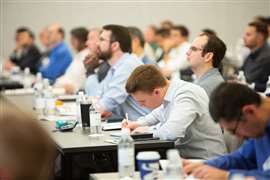Hydrogen Summit underscores challenges, opportunities in hydrogen compression
June 08, 2023
Deep technical discussions, networking highlights of event

Decarbonization—whether pushed by legislation or by company ESG goals—means the production and movement of hydrogen could become a growing part of the COMPRESSORTech2 world.
But there’s still a lot of unknowns about how best to use hydrogen and its effects on everything from metallurgy to valve performance, according to speakers at the COMPRESSORTech2 Hydrogen Summit. The event, held in late April in Houston, drew more than 140 attendees from a range of companies including bp, Atlas Copco, Cook Compression, Dover Precision Components and many more.
Keynotes
Jeff Falkiner, manager, operations & maintenance engineering – transmission operations at Enbridge Gas Inc. (EGI), led off the conference with a morning keynote address highlighting key engineering elements in repurposing natural gas assets for blended hydrogen service.
Falkiner is responsible for engineering support for all compression and ancillary equipment in the storage and transmission operation at EGI, which includes a portfolio of more than 800,000 hp. In his current role, he is deeply involved in the assessments of hydrogen impacts on and the suitability for compression equipment.
Falkiner spoke about some of EGI’s hydrogen projects, including the Markham, Ontario, Canada, hydrogen blending project—the first such project in North America.
The $5.2 million pilot project is a partnership with Cummins and was started in 2018 to help balance Ontario’s electricity supply and demand by storing the province’s surplus electricity as pure hydrogen until it’s needed.
Starting in January 2022, hydrogen from the facility has been injected into a portion of Enbridge Gas’ existing natural gas system serving about 3,600 customers in Markham.

He noted the company needed to create a specific operational and integrity management program to track and quantify the safety and reliability of the network. It even developed and delivered training programs for first responders so they would know how to deal with blended natural gas.
The afternoon keynote was given by Jacob Saletsky, an engineer who supports Williams’ New Energy Ventures group in Tulsa, OK. Saletsky supports the development and execution of projects centered around decarbonization of existing natural gas gathering, processing, and transmission assets, and is also involved with energy transition technologies such as hydrogen, ammonia, carbon capture, renewable natural gas, waste heat recovery, and utility-scale solar.
He noted that hydrogen-based fuels like ammonia and methanol have advantages over other carbon reduction paths like carbon capture or electric drive technology.
He also spoke about the recent field test in Wyoming on a legacy Cooper 6V-250 reciprocating engine. Various percentages of hydrogen—up to 30%--were added to the engine’s fuel to find the effects on output of nitrous oxide, carbon dioxide, methane, NOX and other pollutants.
At 100% engine torque, a 30% blend of hydrogen reduced nitrous oxide by almost 25% when compared to full natural gas, and roughly 12% of methane. The only pollutant to increase during the testing was NOX. But Saletsky said NOX can be reduced without engine upgrades by leaning out the fuel further, but only to a point.
The summit’s other speakers covered a broad range of topics addressing hydrogen and its impacts on the technologies used in gas compression. With hydrogen expected to play a critical role in the future energy mix, this is an event not to miss for anyone involved at any level of the gas compression industry.
Compressor types
Peter Roth, director of PPI products at Sundyne, spoke about the strengths and weaknesses of different compressor types when it comes to hydrogen. For example, centrifugal compressors can handle very large gas flows and are good for pipeline, recirculation and drying applications, but one drawback is that they have moderate pressure ratios. Diaphragm compressors won’t leak hydrogen to the atmosphere, but aren’t feasible for larger flows. Recip compressors can handle larger gas flows, but contamination of the gas is possible from the oil lubricated pistons.
In addition to Sundyne, he has worked with Siemens Energy, Rolls Royce Energy Systems and MAN Turbo & Diesel.
 The afternoon keynote was given by Jacob Saletsky, an engineer who supports Williams’ New Energy Ventures group in Tulsa, OK.
The afternoon keynote was given by Jacob Saletsky, an engineer who supports Williams’ New Energy Ventures group in Tulsa, OK.
Marybeth McBain, senior sales engineer for Elliott Group, spoke about the potential effects on the pipeline and fueling system infrastructure to meet the need to produce, transport and store hydrogen. For one thing, you need a higher volumetric flow of hydrogen to get the energy equivalent of natural gas. That potentially impacts the number of compression stations needed or at least the energy needed to move the larger volume of gas.
For the most part, the compression requirements for hydrogen are similar from production to transport, requiring booster units, pipeline transport compressors, storage compression and possibly fueling station pumps or compressors.
In her current role, McBain covers the market in North and South America for engineered products, which includes LNG compressors, pipeline transport, downstream/refinery compressors and hydrogen and CO2 applications.
Burak Bekisli and Paul Modern discussed challenges associated with high-pressure, non-lubricated hydrogen reciprocating compression. Bekisli is director of materials engineering at Dover Precision Components and Modern is chief engineer for valve and flow control products at Cook Compression, their presentation discussed some of the challenges associated with hydrogen compression and illustrate ways to solve those problems through case studies.
The said the hydrogen market is evolving, driven primarily by decarbonization targets. Many see hydrogen as an excellent energy vector and storage medium.
New applications for reciprocating compression include storage and transportation applications, refueling and pipelines. The noted hydrogen is inherently difficult to seal and to minimize potential leak paths, finished and tolerances are critical.
They also took a deep dive into the limits of PTFE-based materials in hydrogen applications, noting they are less applicable at elevated pressures.
Field tests
A presentation by Jordan Smith and Hans Mathews of Cooper Machinery Services highlighted the company’s experiments in use of hydrogen in its gas engines and its field testing of a large bore slow-speed integral engine running on a 30% hydrogen fuel blend.
They noted that hydrogen has a fast flame speed—roughly 10 times that of methane—that requires ignition time delay to avoid ‘knock’.
The company ran a field test with Southern Star gas line company on a Cooper-Bessemer GMVH-12 integral engine-compressor. Testing so far has been deemed successful, with the unmodified large-bore two-stroke will handle roughly 30% hydrogen by volume.
They also found that even small amounts of hydrogen added to the fuel mix can bring emissions reductions. They found that hydrogen acts as a 2:1 lever on CO reduction and a 1.5:1 lever on methane reduction. Adding hydrogen also improved the engine’s heat rate and improved combustion quality.
On the downside, the increase in NOX output requires a mitigation strategy, carbon dioxide reduction is less than 1:1 for the carbon reduction. And fuel flow increases as hydrogen increases.
Mathews joined the gas pipeline and compression industry in 1991 with Tenneco, where he spent nine years in engineering, maintenance and analysis before joining Hoerbiger in 2000. There, he became senior vice president and general manager for their Engineering Services (HES) team. HES was acquired by Cooper in 2020.
Smith is VP of sustainability & emerging tech at Cooper Machinery Services. He is a 20-year veteran of the compression industry who specialized in the design of emissions reduction technologies for large power generation and gas compression engines while at Cameron Inc. He has held engineering and sales management roles and received his P.E. certification in Colorado.
Joel Sanford, senior key expert, Technology and Innovation Group at Siemens Energy, spoke with Steve Chaykosky, who is senior key expert in Reciprocating Compressor Engineering group at Siemens Energy.
The two discussed valve performance, a key element for reliability and efficiency of reciprocating compressors. They noted that, although hydrogen is just gaining notice in some markets, the gas has been used for decades in a number of industries. Siemens’ Magnum valves were first applied to hydrogen applications in 1997 and are designed to withstand high differential pressures and discharge pressures and can be used in all stages of compression.
They presented a case study about a U.S. refinery’s hydrogen compressors. Between 2000-2002, the refinery’s fleet of 21 compressors (with 50 cylinders in continuous operation averaged 16 valve failures a year. To avoid unscheduled down time, the company would simply have a crew of mechanics change valves every three to four weeks.
Using the same compression fleet, the refinery installed Magnum valves in 2003, with most cylinders being outfitted with the Magnum valves by 2007. The number of valve failures dropped to an average of two a year.
Impact of IRA
After the technical presentations, delegates heard a panel discussion entitled, “The changing shape of our energy infrastructure.” Noureen Faizee, director, strategy & growth – hydrogen at Worley; Luiz Soriano, sales and business development manager at Siemens Energy; and Patrick McCalley, sales and product manager, hydrogen economy- Americas, with NEA Group, took part.
The panelists talked about the effects of the Inflation Reduction Act on capital investments toward alternative energy and what that might mean for hydrogen compression. The Inflation Reduction Act offers a tax credit for hydrogen production, known as the “45V” tax credit, subsidizes either investment in clean hydrogen production or hydrogen production itself. The value of the 45V credit increases as the life-cycle emissions associated with hydrogen production decrease.
In the short term, the increased tax credit for carbon capture and sequestration, a credit known as “45Q,” also could have a large effect on reducing emissions associated with hydrogen production. Some suggest that the tax credits in the IRA already are sufficient to make hydrogen production from natural gas with carbon capture and sequestration competitive with current hydrogen production without carbon capture and sequestration].
COMPRESSORTech2 plans on holding another Hydrogen Summit, likely in the Houston area, in April 2024.
MAGAZINE
NEWSLETTER

CONNECT WITH THE TEAM







